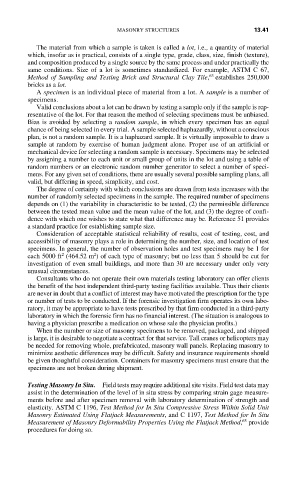Page 496 - Forensic Structural Engineering Handbook
P. 496
MASONRY STRUCTURES 13.41
The material from which a sample is taken is called a lot, i.e., a quantity of material
which, insofar as is practical, consists of a single type, grade, class, size, finish (texture),
and composition produced by a single source by the same process and under practically the
same conditions. Size of a lot is sometimes standardized. For example, ASTM C 67,
63
Method of Sampling and Testing Brick and Structural Clay Tile, establishes 250,000
bricks as a lot.
A specimen is an individual piece of material from a lot. A sample is a number of
specimens.
Valid conclusions about a lot can be drawn by testing a sample only if the sample is rep-
resentative of the lot. For that reason the method of selecting specimens must be unbiased.
Bias is avoided by selecting a random sample, in which every specimen has an equal
chance of being selected in every trial. A sample selected haphazardly, without a conscious
plan, is not a random sample. It is a haphazard sample. It is virtually impossible to draw a
sample at random by exercise of human judgment alone. Proper use of an artificial or
mechanical device for selecting a random sample is necessary. Specimens may be selected
by assigning a number to each unit or small group of units in the lot and using a table of
random numbers or an electronic random number generator to select a number of speci-
mens. For any given set of conditions, there are usually several possible sampling plans, all
valid, but differing in speed, simplicity, and cost.
The degree of certainty with which conclusions are drawn from tests increases with the
number of randomly selected specimens in the sample. The required number of specimens
depends on (1) the variability in characteristic to be tested, (2) the permissible difference
between the tested mean value and the mean value of the lot, and (3) the degree of confi-
dence with which one wishes to state what that difference may be. Reference 51 provides
a standard practice for establishing sample size.
Consideration of acceptable statistical reliability of results, cost of testing, cost, and
accessibility of masonry plays a role in determining the number, size, and location of test
specimens. In general, the number of observation holes and test specimens may be 1 for
2
2
each 5000 ft (464.52 m ) of each type of masonry; but no less than 5 should be cut for
investigation of even small buildings, and more than 30 are necessary under only very
unusual circumstances.
Consultants who do not operate their own materials testing laboratory can offer clients
the benefit of the best independent third-party testing facilities available. Thus their clients
are never in doubt that a conflict of interest may have motivated the prescription for the type
or number of tests to be conducted. If the forensic investigation firm operates its own labo-
ratory, it may be appropriate to have tests prescribed by that firm conducted in a third-party
laboratory in which the forensic firm has no financial interest. (The situation is analogous to
having a physician prescribe a medication on whose sale the physician profits.)
When the number or size of masonry specimens to be removed, packaged, and shipped
is large, it is desirable to negotiate a contract for that service. Tall cranes or helicopters may
be needed for removing whole, prefabricated, masonry wall panels. Replacing masonry to
minimize aesthetic differences may be difficult. Safety and insurance requirements should
be given thoughtful consideration. Containers for masonry specimens must ensure that the
specimens are not broken during shipment.
Testing Masonry In Situ. Field tests may require additional site visits. Field test data may
assist in the determination of the level of in situ stress by comparing strain gage measure-
ments before and after specimen removal with laboratory determination of strength and
elasticity. ASTM C 1196, Test Method for In Situ Compressive Stress Within Solid Unit
Masonry Estimated Using Flatjack Measurements, and C 1197, Test Method for In Situ
63
Measurement of Masonry Deformability Properties Using the Flatjack Method, provide
procedures for doing so.

